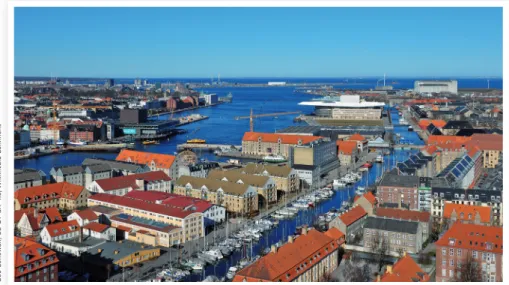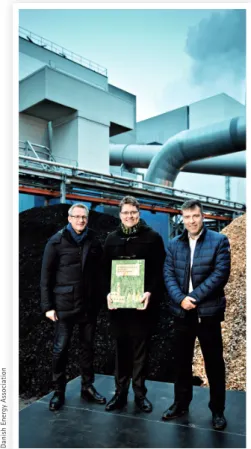BIOMASSE-DOSSIER BIOMASS IN THE INTERNA TIONAL CONTEXT
1 where district heating or natural gas is
available from 2016 onwards
• committing 5.5 million € to fund the conversion from oil-fired boilers and natural gas boilers in existing buildings to renewable energy.
As a result Renewable Energy Sources (RES) are expected to account for about 80 % in the power and heat sector by 2020 (Fig. 1).
Biomass district heating for Copenhagen and other cities
Denmark’s ten major cities have city-wide district heating schemes where most of the heat (95 % to 98 %) used to be produced in large coal- or gas-fired CHP plants and waste incineration CHP plants. Most of these plants are currently changing pro- duction from fossil fuels to sustainable bio-
mass. Copenhagen is one of these cities and the change to biomass is the most import- ant initiative in reaching the goal of being independent from fossil fuels in 2025.
One of the main reasons for this de- velopment is that the Energy Agreement made it more attractive to convert from coal to biomass at large-scale CHP plants.
D
enmark has, as one of the only count- ries in Europe, a long term objecti- ve for the independence of fossil fuels by 2050. This goal is supported by 90 % of the Danish Parliament. The objective was set in a comprehensive, broad political energy ag- reement from 2012 which contained a wide range of initiatives for the time period from 2012 to 2020.The agreement especially provided in- centives for large investments in renewable energy: biomass as well as onshore- and offshore wind energy. Furthermore the ag- reement supports the phasing-out of oil-fi- red boilers in existing buildings by:
• banning the installation of oil-fired boilers and natural gas boilers in new buildings from 2013 onwards
• banning the installation of new oil-fi- red boilers in existing buildings in areas
Kristine van het Erve Grunnet
Biomass in the international Context – how to safeguard Sustainability
Fig. 2: The production of renewable energies, especially biomass and wind power, has experienced a steep rise in Denmark during the last 35 years.
This was made possible by allowing produ- cers and consumers to make price agree- ments. In this way the tax benefit of bio- mass could be split – and local consumer‘s demand for green and climate friendly heat could be satisfied. In addition subsidy sche- mes have also supported the development of the transition.
0 30 60 90 120 150
Production of renewable energies in Denmark by type 1980 to 2014
Heat pumps etc.
Wind
Waste, renewable Biogas Straw Wood PJ
1980 1982 1984 1986 1988 1990 1992 1994 1996 1998 2000 2002 2004 2006 2008 2010 2012 2014
Source: Danish Energy Association
Fig. 1: The Renewable Energy Sources are expected to account for about 80 % in the Danish power and heat sector by the year 2020.
0 20 40 60 80 100
Share of Renewable Energy Sources in the Danish power and heat sector
Percent
2005 2006 2007 2008 2009 2010 2011 2012 2013 2014 2015 2016 2017 2018 2019 2020
Source: Danish Energy Association
Port of Copenhagen – the Danish capital has set a goal for 100 % renewable energy by 2025, hereby biomass district heating plays an important role.
© Bob Collowan, CC-BY-SA-4.0, Wikimedia Commons
erschienen 08/2016 in der Broschüre „Bioenergie und Umweltschutz“ des ÖBMV
2 In 2014 approximately 26 % of final energy
consumption came from renewable energy sources whereof bioenergy is the most im- portant source.
The consumption of solid biomass for electricity and district heating is expected to rise from less than 58 Petajoule in 2014 to 113 Petajoule in 2025. All in all Denmark expects an increase in the consumption of solid biomass of 50 % over the period from 2012 to 2025. This is accompanied by an expected decline in the consumption of coal and gas for CHP plants
Imports of pellets and wood chips
Denmark will import most of the solid bio- mass used for CHP production. Today 95 % of the wood-pellets and 33 % of the wood- chips are imported. With the expected in- crease in solid biomass the political parties behind the Energy Agreement requested more information on the use of bioenergy in Denmark.
The government therefore carried out a comprehensive analysis of the use of bio- mass. The analysis concluded that the move by combined heat and power (CHP) plants to wood pellets and wood chips is good for the
The conclusion of the Danish Industry Agreement to do- cument sustainability was well received by the industry.
© Danish Energy Association
Total 2.1 M tons
Latvia
Estonia Russia
Sweden Portugal Germany
Danish imports of pellets by country of origin
27,6 % Latvia 19,1 % Estonia
1,6 % Lithuania 16,6 % Russia
0,9 % Belarus 0,2 % Ukraine 6,5 % Sweden
2,4 % Finland 7,1 % Portugal 6,4 % Germany 4,6 % Poland 3,3 % USA
3,7 % Others
climate, when using sustainable biomass.
Furthermore the analysis concluded that Denmark will be able to source wood pellets and wood chips sustainably in the short and medium term. But the analysis also pointed to an increasing risk in the longer term per- spective / after 2020. Expecting that global and regional demands for wood will rise in the long term, this could pose a threat to the sustainability regarding Danish biomass use. Given the limited, short-term supply of wood from thinning and residual wood products, customers may be „pushed” in the direction of buying wood products that are not sustainably produced.
Voluntary industry agreement instead of regulations
As a result, the former energy minister re- quested the industry to enter into a volun- tary agreement to purchase only sustaina- bly produced biomass. The alternative being that the government would move to ensure sustainability through regulation. To the members of the District Heating Associa- tion and the Danish Energy Association the issue of sustainability was not a new thing.
Members have strived to source biomass sustainably for years.
However, there was a general understan- ding of the need to document sustaina- bility. Thus the industry accepted the challenge from the former Minister. In De- cember 2014 the Danish Energy Association and the Danish District Heating Association made their agreement regarding sustaina- ble biomass public. The agreement was well received across policy makers, NGOs and industry.
An industry agreement is not the most common approach but very much in line with Danish traditions. The Netherlands, the United Kingdom and Belgium have op- ted for regulations to document the sus- tainable use of biomass. However, the vo- luntary agreement will provide the same guarantee of securing sustainable biomass as regulation, but in a flexible and less bu- reaucratic manner. The agreement is based on existing regulation and guidelines on sustainable forests management. The ag- reement reflects
1) the contents of the Danish Ministry of Environment’s guidelines on securing sustainable timber in public procure- ments of goods and services and 2) Forest Europe’s criteria for sustainable
forest management.
Fig. 4: Most of the pellet imports to Denmark are delivered by countries from Eastern Europe.
Source: Danish Energy Association
0 5 10 15 20 25 30
Share of renewable energy in total energy consumption in Denmark
Share covered by net imports Share covered by
indigeneous production
Fig. 3: The consumption of renewable energy has risen to a share of around 26 % in the last years.
Source: Danish Energy Association 1980 1982 1984 1986 1988 1990 1992 1994 1996 1998 2000 2002 2004 2006 2008 2010 2012 2014
Percent
BIOMASSE-DOSSIER BIOMASS IN THE INTERNA TIONAL CONTEXT
3
As ambitious as
most stringent legislations
The agreement is as ambitious as the most stringent legislation in place. It matches the UK regulation, both regarding the ele- ments included and the level of ambition.
Furthermore a voluntary agreement can be implemented without a large administrati- ve set-up. If European regulation on bio- mass sustainability becomes a reality, the agreement will be easily replaced by it. The agreement is based on the experience of the industry and has been made with input, help and support of its members.
Eight criteria for sustainable biomass
The agreement basically consist of eight criteria that all solid biomass used by the CHP plants must meet (Tab. 1). The first six criteria concern the management of sustainable forestry and correspond to a great extent with Forest Europe‘s criteria for sustainable forest management. The se- venth criterion focuses on the reduction of CO2 (based on the whole value chain). The eighth and last criterion deals with indirect effects such as carbon debt and cascading.
The first seven criteria are binding whereas the eighth is a recommendation.
The CHP plants are responsible for com- plying with the agreement and for docu- menting compliance through an annual report. Three certification schemes can be
Tab. 1: The criteria of the Danish Industry Agreement
1. Legality Legality of forest management and utilisation is safeguarded.
2. Ecosystems Protection of forest ecosystems
3. Carbon cycle Forests productivity and ability to contribute to the global carbon circle must be maintained.
4. Condition of forests The forests must be healthy and well-functioning.
5. Biodiversity Protection of biodiversity, sensitive areas and areas worthy of preservation 6. Rights Social and work-related rights must be respected.
7. CO2-Limits CO2-emissions from the biomass value chain 8. Carbon cycle Forest carbon stock, iluc, iwuc
Source: Dansk Energi, Dansk Fjernvarme
used to show compliance. The three sys- tems are SBP (Sustainable Biomass Partner- ship), FSC and PEFC.
Certification systems with third party verification
The report must be either developed or ver- ified by an independent third party that is either accredited to undertake FSC or PEFC forest certification, SBP certification or by an organization that is EU-approved as an EUTR monitoring organization. After publi- cation the reports will be available on the two associations’ websites.
The Danish Industry Agreement ensures the sustainable use of solid biomass in CHP plants (wood pellets and wood chips) in Denmark. The same can be said for regula- tion in Holland, the UK and Belgium.
The problem is that the sustainable use of biomass is close to but not exactly the same in the four countries. And some countries have no schemes at all to ensure sustainability. This leads to uncertainties in the market, lack of transparency and an uneven playing field. Denmark therefore urges the EU to work for binding European sustainability criteria for the use of solid biomass.
Kristine van het Erve Grunnet Senior Advisor,
Dansk Energi/Danish Energy Association, keg@danskenergi.dk


